Characteristics of the Water Vapor Transport in the Canyon Area of the Southeastern Tibetan Plateau
Abstract
:1. Introduction
2. Data and Methods
2.1. Study Area
2.2. Data
- (1)
- The global data assessment system (GDAS) data were obtained from the National Centers for Environmental Prediction (NCEP) of the United States (https://www.ready.noaa.gov/gdas1.php, accessed on 8 September 2020). The data were stored as 5 weeks for each month. The horizontal resolution of the data is 1° × 1°.
- (2)
- The NCEP/NCAR reanalysis data were obtained from the NCEP of the United States. We used the air temperature (air), u wind speed (uwnd), v wind speed (vwnd), and relative humidity (Rhum) data as the input for HYSPLIT_v4, and the horizontal resolution of the data is 2.5° × 2.5° (https://psl.noaa.gov/data/gridded/data.ncep.reanalysis.html, accessed on 10 May 2020).
- (3)
- The variables used in the reanalysis of the ERA-5 data (https://www.ecmwf.int/en/about/media-centre/science-blog/2017/era5-new-reanalysis-weather-and-climate-data, accessed on 18 October 2020) from the European Center for Medium Range Weather Forecasts (ECMWF) are the sensible heat flux (SSHF), the latent heat flux(SLHF), water vapor flux divergence integral (VIMDF, the vertical integral of the moisture flux is the horizontal rate of flow of moisture, per meter across the flow, for a column of air extending from the surface of the Earth to the top of the atmosphere), and the monthly mean water vapor flux from north to east. The horizontal resolution of the data is 0.1° × 0.1°. The time range of the data used in this study is from 1989 to 2019.
2.3. Water Vapor Transport Trajectory Model (HYSPLIT_v4)
2.4. Singular Value Decomposition (SVD) Method
3. Results Analysis
3.1. Water Vapor Transport Trajectories in the Canyon Area in Southeastern Tibet
3.2. Effect of Surface Fluxes on Water Vapor Transport
3.2.1. Relationship between Sensible Heat Flux and Water Vapor Flux Divergence in the Canyon Area of Southeastern Tibet
3.2.2. Relationship between the Latent Heat and the Water Vapor Flux Divergence in the Canyon Area of Southeastern Tibet
3.2.3. Relationships between the Surface Sensible Heat, Latent Heat, and Northward Water Vapor Flux
3.2.4. Influences of the Surface Sensible Heat and Latent Heat on the Water Eastward Vapor Flux
4. Summary and Conclusions
- (1)
- The sources of the water vapor were different during the Asian monsoon and non-Asian monsoon seasons, and the main sources of the water vapor in the study area during the non-AMS were from the west and southwest. During the AMS, there was mainly southwest air flow and a small amount of southeast air flow in the lower layer. The westerly flow and northwesterly flow were the main sources of water vapor in winter. During the AMS, the southwestern water vapor transport accounted for more than half of the total. There was a certain correlation between the transportation height of each station and the source of water vapor. The height of the water vapor transportation channel of the western air flow was higher than 3000 m, and the height of the water vapor transportation channel of the southwestern and southeastern air flows was about 2000 m.
- (2)
- The sensible heat and latent heat in the northern part of the southeastern Tibet Canyon during the non-AMS were directly proportional to the change in the northward water vapor flux in the central and eastern parts of the plateau. During the AMS, the sensible heat and latent heat were directly proportional to the northward water vapor flux. When the sensible heat and latent heat decreased during the non-AMS, the eastward water vapor flux increased. The sensible heat and latent heat were negatively correlated with the eastward water vapor flux, while the sensible heat and latent heat were positively correlated with the eastward water vapor flux during the AMS.
- (3)
- There was a negative correlation between the surface fluxes and the water vapor flux divergence in this area. The southwest boundary of southeast Tibet was the key area affecting the water vapor flux divergence. When the surface sensible and latent heat fluxes increased in southeastern Tibet, the divergence of the water vapor flux decreased, that is, the water vapor transport to the region was weakened. When the sensible and latent heat fluxes decreased, the divergence of water vapor flux increased and the water vapor transport increased.
- (4)
- During the non-AMS, when the sensible heat in the canyon area of southeastern Tibet decreased, the eastward water vapor flux increased. Additionally, the northward water vapor fluxes on the plateau east of 75° E increased, while they decreased on the western part. When the latent heat increased, the eastward water vapor flux decreased, and the sensible heat and latent heat were negatively correlated with the northward water vapor flux during the non-AMS. That is, when the surface flux increased in southeastern Tibet, the water vapor transport from west to east increased. During the AMS, when the sensible heat and latent heat in southeastern Tibet increased as a whole, the eastward water vapor flux in the total-column in southeastern Tibet increased. This indicates that when the surface flux in southeastern Tibet increased during the AMS, the water vapor transport increased from west to east.
Author Contributions
Funding
Institutional Review Board Statement
Informed Consent Statement
Data Availability Statement
Acknowledgments
Conflicts of Interest
References
- Li, G.P. Dynamic Meteorology of Qinghai-Tibet Plateau; Meteorological Press: Beijing, China, 2002. [Google Scholar]
- Xu, X.; Lu, C.; Shi, X.; Gao, S. World water tower: An atmospheric perspective. Geophys. Res. Lett. 2008, 35. [Google Scholar] [CrossRef]
- Jane, Q. The third pole. Nature 2008, 454, 393–396. [Google Scholar]
- Yao, T.; Masson-Delmotte, V.; Gao, J.; Yu, W.; Yang, X.; Risi, C.; Sturm, C.; Werner, M.; Zhao, H.; He, Y.; et al. A review of climatic controls on δ18O in precipitation over the Tibetan Plateau: Observations and simulations. Rev. Geophys. 2013, 51, 525–548. [Google Scholar] [CrossRef]
- Wu, G.; Liu, Y.; Zhang, Q.; Duan, A.; Wang, T.; Wan, R.; Liu, X.; Li, W.; Wang, Z.; Liang, X. The Influence of Mechanical and Thermal Forcing by the Tibetan Plateau on Asian Climate. J. Hydrometeorol. 2007, 8, 770–789. [Google Scholar] [CrossRef] [Green Version]
- Meng, X.N.; Liu, H.Z.; Du, Q.; Liu, Y.; Xu, L.J. Factors controlling the latent and sensible heat fluxes over erhai lake under different atmospheric surface layer stability conditions. Atmos. Ocean. Sci. Lett. 2020, 13, 400–406. [Google Scholar] [CrossRef]
- Ren, Q.; Zhou, C.Y.; Xia, Y.; Cen, S.X.; Long, Y. Interannual relationship between spring sensible heat flux over the eastern Tibetan Plateau and temperature in eastern China. J. Glaciol. Geocryol. 2019, 41, 783–792. [Google Scholar]
- Wang, J.; Tong, J.L.; Xiao, Y.Q.; Wu, X.Y.; Zhang, W.Y. The interannual variation of summer sensible heat flux in typical arid and semi-arid regions of East Asia. Arid Meteorol. 2018, 36, 203–211. [Google Scholar]
- Odhiambo, G.O.; Savage, M.J. Sensible heat flux by surface layer scintillometry and eddy covariance over a mixed grassland community as affected by bowen ratio and most formulations for unstable conditions. J. Hydrometeorol. 2009, 10, 479–492. [Google Scholar] [CrossRef]
- Zou, H.; Zhou, L.B.; Ma, S.P.; Wang, P.; Li, W.; Jia, A.G.; Gao, J.J.; Deng, Y. Local wind system in the Rongbuk valley on the northern slope of Mt. Everest. Geophys. Res. Lett. 2008, 35, 344–349. [Google Scholar] [CrossRef]
- Ye, D.Z. Meteorology of Qinghai Tibet Plateau; Science Press: Beijing, China, 1979. [Google Scholar]
- Zhang, Q.; Wang, R.; Yue, P.; Zhao, Y.D. Discussion on some scientific problems in the field of land air interaction under complex conditions. Acta Meteorol. Sin. 2017, 75, 39–56. [Google Scholar]
- Xu, X.; Zhao, T.; Lu, C.; Guo, Y.; Chen, B.; Liu, R.; Li, Y.; Shi, X. An important mechanism sustaining the atmospheric “water tower” over the Tibetan Plateau. Atmos. Chem. Phys. 2014, 14, 11287–11295. [Google Scholar] [CrossRef] [Green Version]
- Tao, S.; Ding, Y. Observational evidence of the influence of the Qinghai-Xizang (Tibet) Plateau on the occurrence of heavy rain and severe convective storms in China. Bull. Am. Meterol. Soc. 1981, 62, 23–30. [Google Scholar] [CrossRef]
- Liang, H. Distribution and Variation of Atmospheric Water Vapor over the Tibetan Plateau and Its Surrounding Areas. Ph.D. Thesis, Chinese Academy of Meteorological Sciences, Beijing, China, 2005. [Google Scholar]
- Liang, H.; Liu, J.M.; Zhang, J.C.; Bi, Y.M.; Wang, K.C. Research on Retrieval of the Amount of Atmospheric Water Vapor over Qinghai-Xizang Plateau. Plateau Meteorol. 2006, 025, 1055–1063. [Google Scholar]
- Jiang, J.X.; Fan, M.Z. A preliminary study on the relationship between TBB field and water vapor distribution over the Tibetan Plateau in summer. Plateau Meteorol. 2002, 21, 20–24. [Google Scholar]
- Ding, Y.G.; Jiang, Z.H. Universality of SVD method in meteorological field diagnosis and analysis. Acta Meteorol. Sin. 1996, 54, 365–372. [Google Scholar]
- Qu, Y.L.; Zhang, C.D. The distribution and structure of water vapour flux field over East Asia in summer. Plateau Meteorol. 1985, 4, 121–128. [Google Scholar]
- Massacand, A.C.; Wernli, H.; Davies, H.C. Heavy precipitation on the Alpine southside: An upper-level precursor. Geophys. Res. Lett. 1998, 25, 1435–1438. [Google Scholar] [CrossRef]
- Bertò, A.; Buzzi, A.; Zardi, D. Back—tracking water vapour contributing to a precipitation event over Trentino: A case study. Meteorol. Z. 2004, 13, 189–200. [Google Scholar] [CrossRef]
- James, P.; Stohl, A.; Spichtinger, N.; Eckhardt, S.; Forster, C. Climatological aspects of the extreme European rainfall of August 2002 and a trajectory method for estimating the associated evaporative source regions. Nat. Hazards Earth Syst. Sci. 2004, 4, 733–746. [Google Scholar] [CrossRef] [Green Version]
- Sodemann, H.; Stohl, A. Asymmetries in the moisture origin of Antarctic precipitation. Geophys. Res. Lett. 2009, 36, 273–289. [Google Scholar] [CrossRef] [Green Version]
- Sodemann, H.; Schwierz, C.; Wernli, H. Interannual variability of Greenland winter precipitation sources: Lagrangian moisture diagnostic and North Atlantic Oscillation influence. J. Geophys. Res. 2008, 113, D03107. [Google Scholar] [CrossRef] [Green Version]
- Li, J.; Tao, T.; Pang, Z.; Tan, M.; Kong, Y.; Duan, W.; Zhang, Y. Identification of different moisture sources through isotopic monitoring during a storm event. J. Hydrometeorl. 2015, 16, 1918–1927. [Google Scholar] [CrossRef]
- Han, T.; Zhang, M.; Wang, S.; Qu, D.; Du, Q. Sub-hourly variability of stable isotopes in precipitation in the marginal zone of East Asian monsoon. Water 2020, 12, 2145. [Google Scholar] [CrossRef]
- Jiang, Z.; Ren, W.; Liu, Z.; Yang, H. Analysis of water vapor transportcharacteristics during the Vleiyu over the Yangtze-Huaihe River valley using the Lagrangian method. Acta Meteor Sin. 2013, 71, 295–304. [Google Scholar]
- Chu, Q.; Wang, Q.; Feng, G.; Jia, Z.; Liu, G. Roles of water vapor sources and transport in the intraseasonal and interannual variation in the peak monsoon rainfall over East China. Clim. Dyn. 2021, 57, 2153–2170. [Google Scholar] [CrossRef]
- Chen, Y.; Luo, Y. Analysis of Paths and Sources of Moisture for the South China Rainfall during the Presummer Rainy Season of 1979–2014. Acta Meteorol. Sin. 2018, 32, 744–757. [Google Scholar] [CrossRef]
- Sun, B.; Wang, H. Moisture Sources of Semiarid Grassland in China489 Using the Lagrangian Particle Model FLEXPART. J. Clim. 2014, 27, 2457–2474. [Google Scholar] [CrossRef]
- Tao, S.; Luo, S.; Zhang, H. The Qinghai-Xizang Plateau Meteorological Experiment (Qxpmex) May–August 1979. In Proceedings of the International Symposium on the Qinghai-Xizang Plateau and Mountain Meteorology, Beijing, China, 20–24 March 1986; pp. 3–13. [Google Scholar]
- Wang, J. Land surface process experiments and interaction study in China-From HEIFE to IMGRASS and GAME-TIBET/TIPEX. Plateau Meteorol. 1999, 18, 280–294. [Google Scholar]
- Ma, Y.; Yao, T.; Wang, J. Experimental study of energy and water cycle in Tibetan plateau—The progress introduction on the study of GAME/Tibet and CAMP/Tibet. Plateau Meteorol. 2006, 25, 344–351. [Google Scholar]
- Ma, Y.; Hu, Z.; Xie, Z.; Ma, W.; Wang, B.; Chen, X.; Li, M.; Zhong, L.; Sun, F.; Gu, L.; et al. A long-term (2005–2016) dataset of hourly integrated land-atmosphere interaction observations on the Tibetan Plateau. Earth Syst. Sci. Data (ESSD) 2020, 12, 2937–2957. [Google Scholar] [CrossRef]
- Dong, W.; Lin, Y.; Wright, J.S.; Ming, Y.; Xie, Y.; Wang, B.; Huang, W.; Huang, J.; Wang, L.; Tian, L.; et al. Summer rainfall over the southwestern Tibetan Plateau controlled by deep convection over the Indian subcontinent. Nat. Commun. 2016, 7, 10925. [Google Scholar] [CrossRef] [PubMed]
- Ma, Y.; Wang, Y.; Han, C. Regionalization of land surface heat fluxes over the heterogeneous landscape: From the Tibetan Plateau to the Third Pole region. Int. J. Remote. Sens. 2018, 39, 5872–5890. [Google Scholar] [CrossRef]
- Li, M.; Babel, W.; Tanaka, K.; Foken, T. Note on the application of planar-fit rotation for non-omnidirectional sonic anemometers. Atmos. Meas. Tech. 2013, 6, 221–229. [Google Scholar] [CrossRef] [Green Version]
- Zhong, L.; Ma, Y.; Hu, Z.; Fu, Y.; Hu, Y.; Wang, X.; Cheng, M.; Ge, N. Estimation of hourly land surface heat fluxes over the Tibetan Plateau by the combined use of geostationary and polar-orbiting satellites. Atmos. Chem. Phys. 2019, 19, 5529–5541. [Google Scholar] [CrossRef] [Green Version]
- Wernli, H. A Lagrangian-based analysis of extratropical cyclones II: A detailed case-study. Q. J. R. Meteorol. Soc. 1997, 123, 1677–1706. [Google Scholar] [CrossRef]
- Nieto, R.; Gimeno, L.; Trigo, R.M. A Lagrangian identificantion of major sources of Sahel moisture. Geophy. Res. Lett. 2006, 33, L18707. [Google Scholar] [CrossRef]
- Cui, Y.F.; Duan, A.M.; Liu, Y.M.; Wu, G.X. Interannual variability of the spring atmospheric heat source over the Tibetan Plateau forced by the North Atlantic SSTA. Clim. Dyn. 2015, 45, 1617–1634. [Google Scholar] [CrossRef]
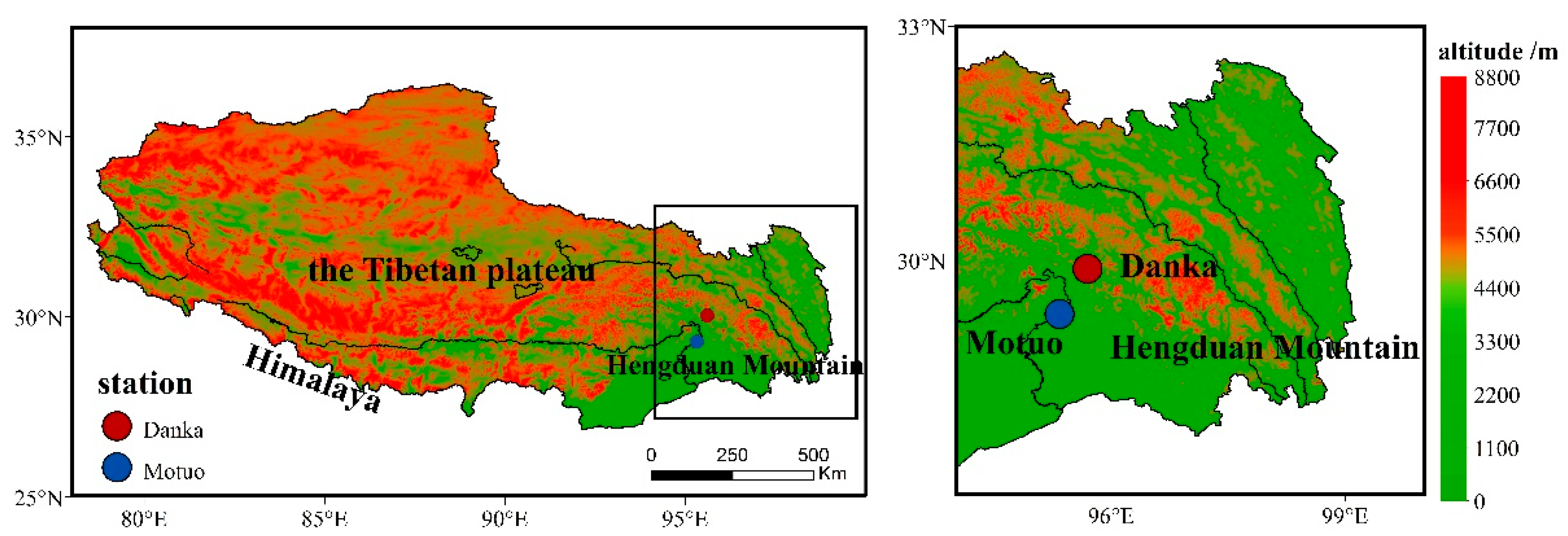
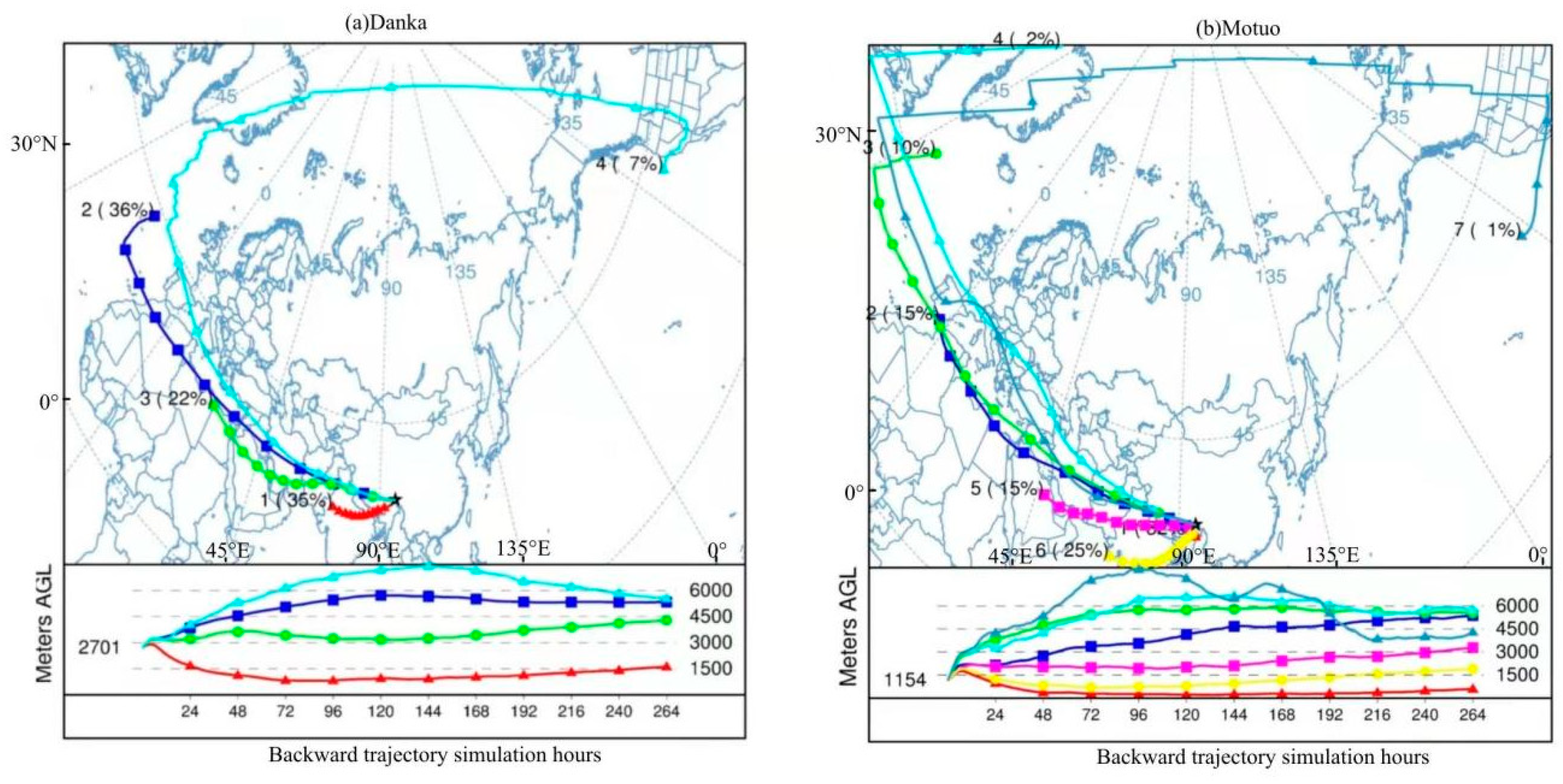
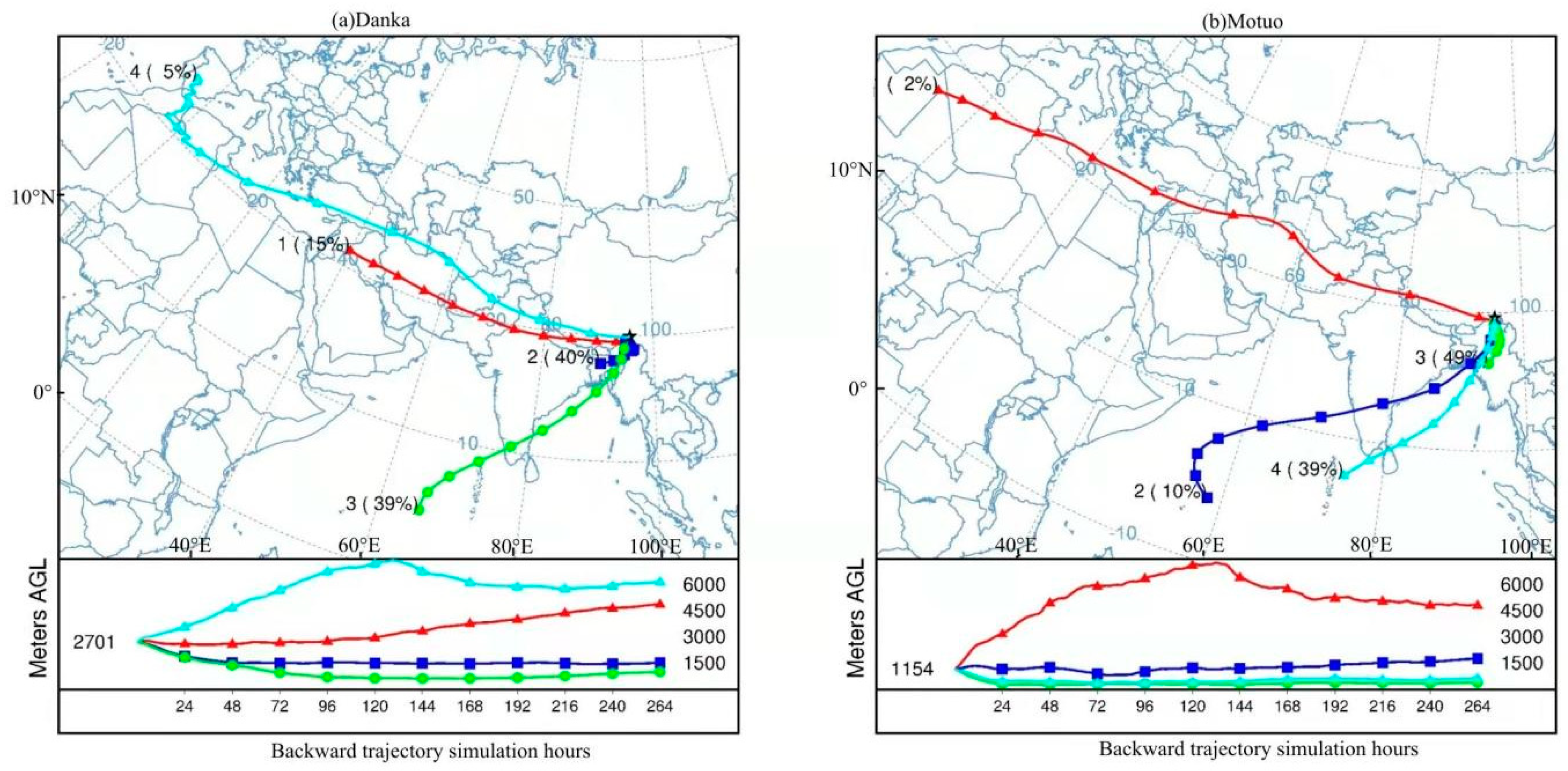
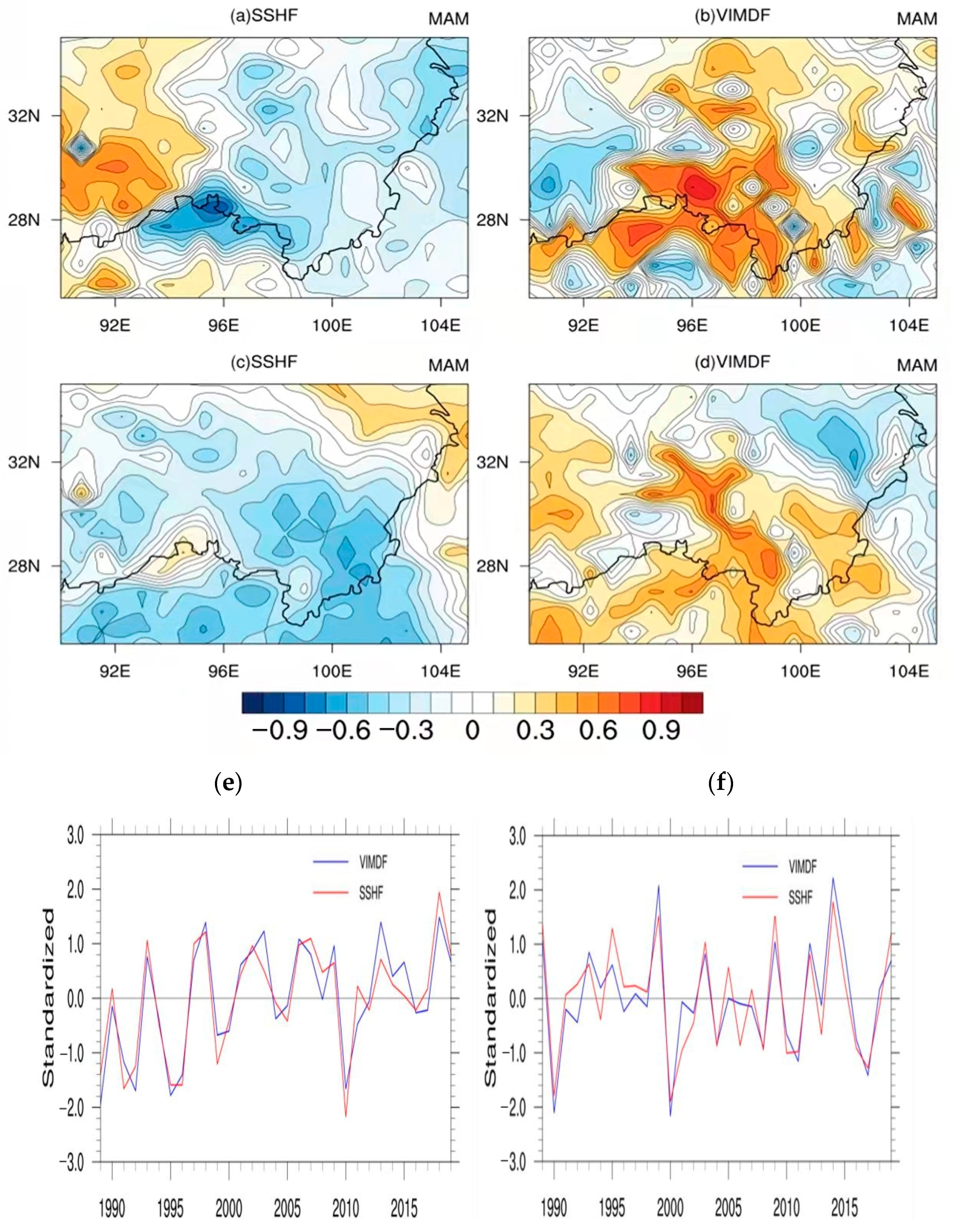

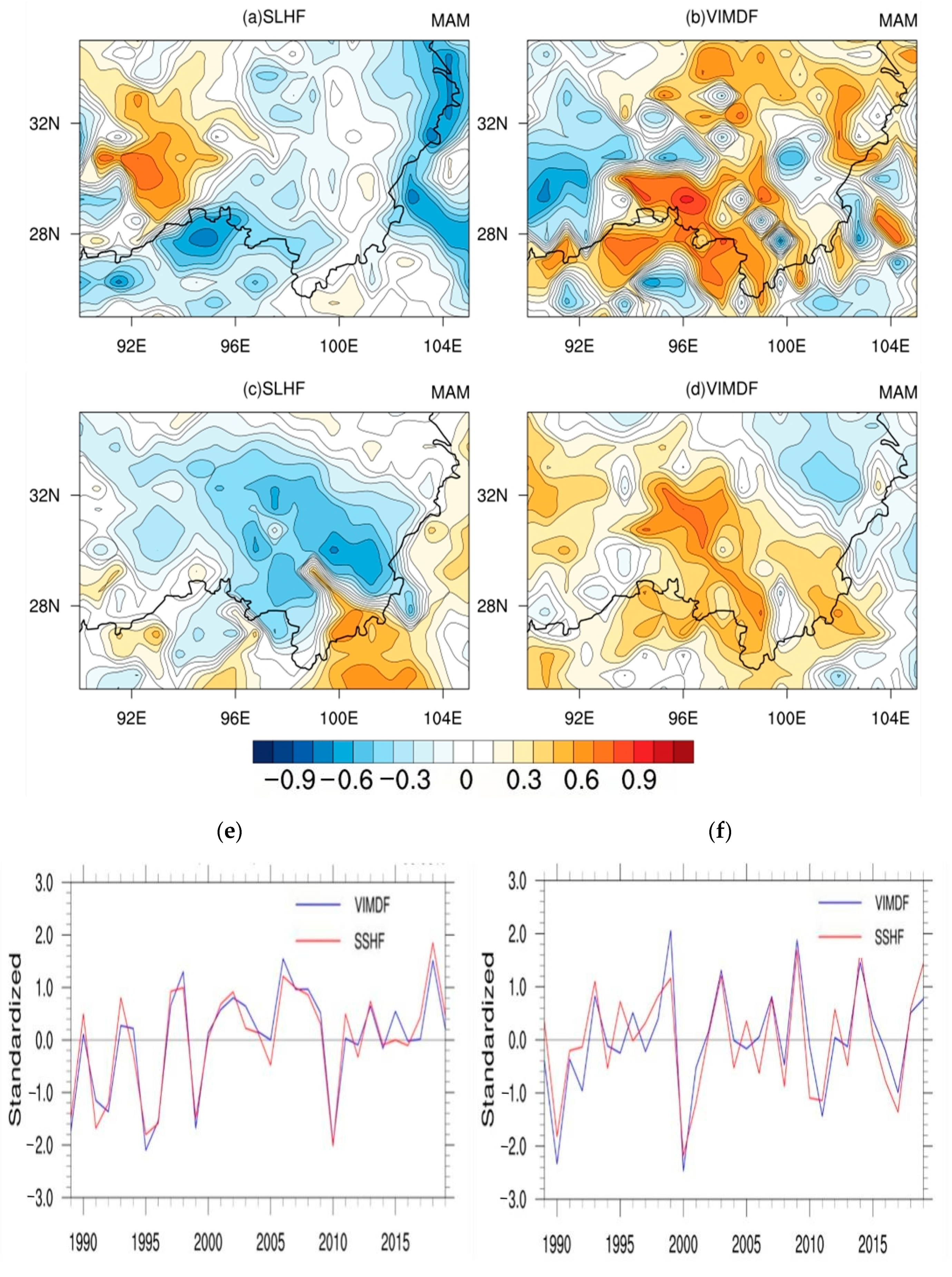
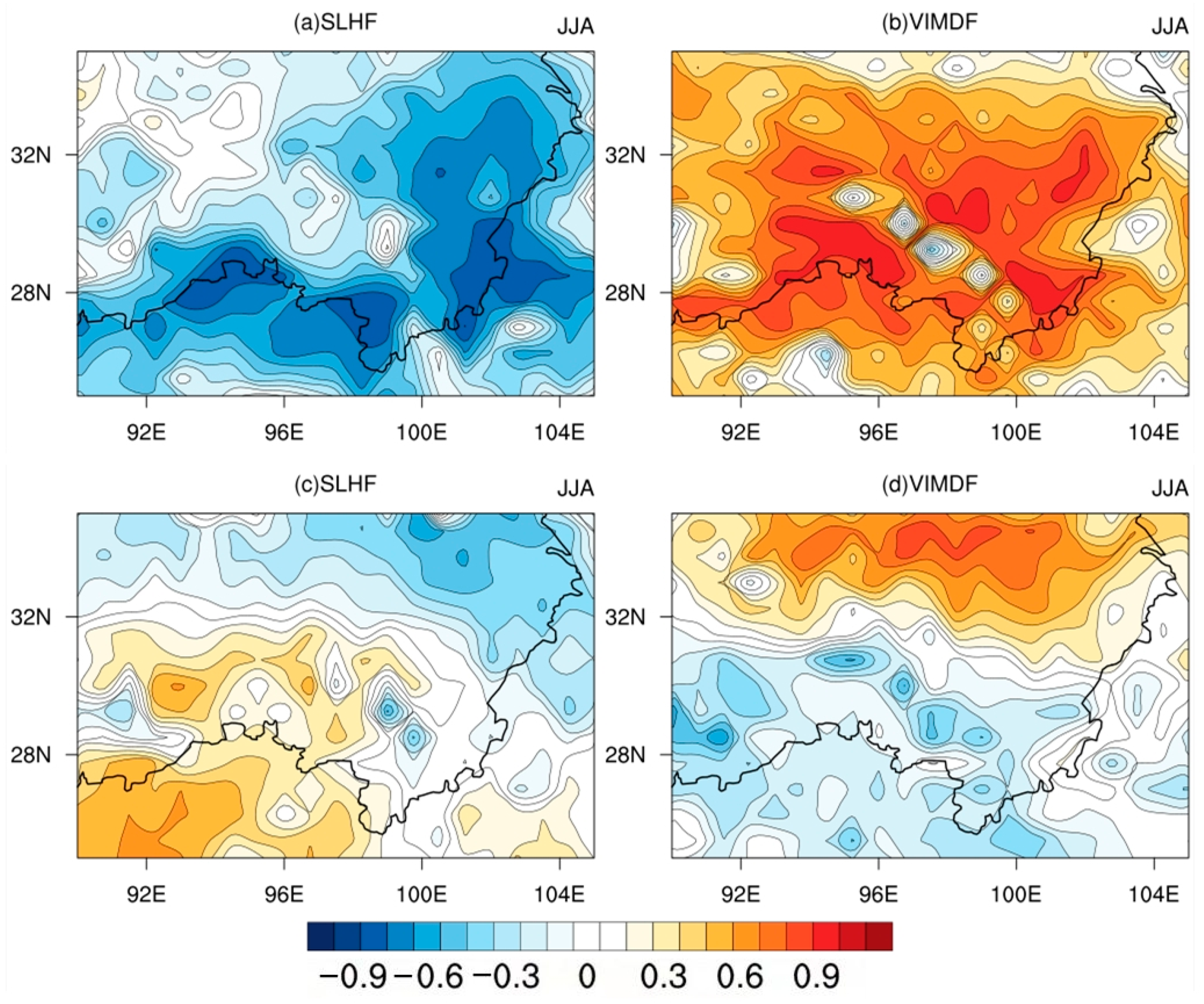
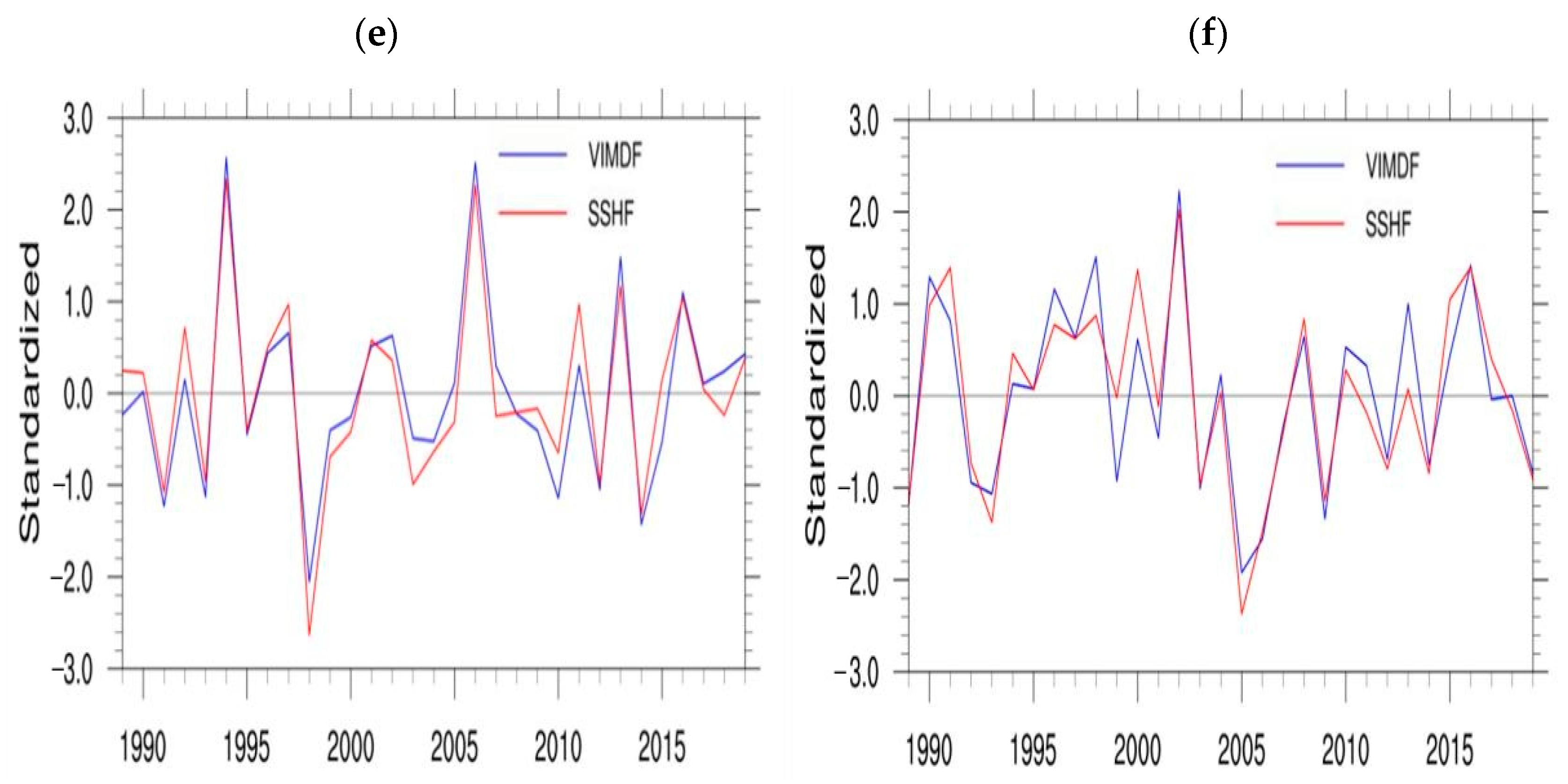
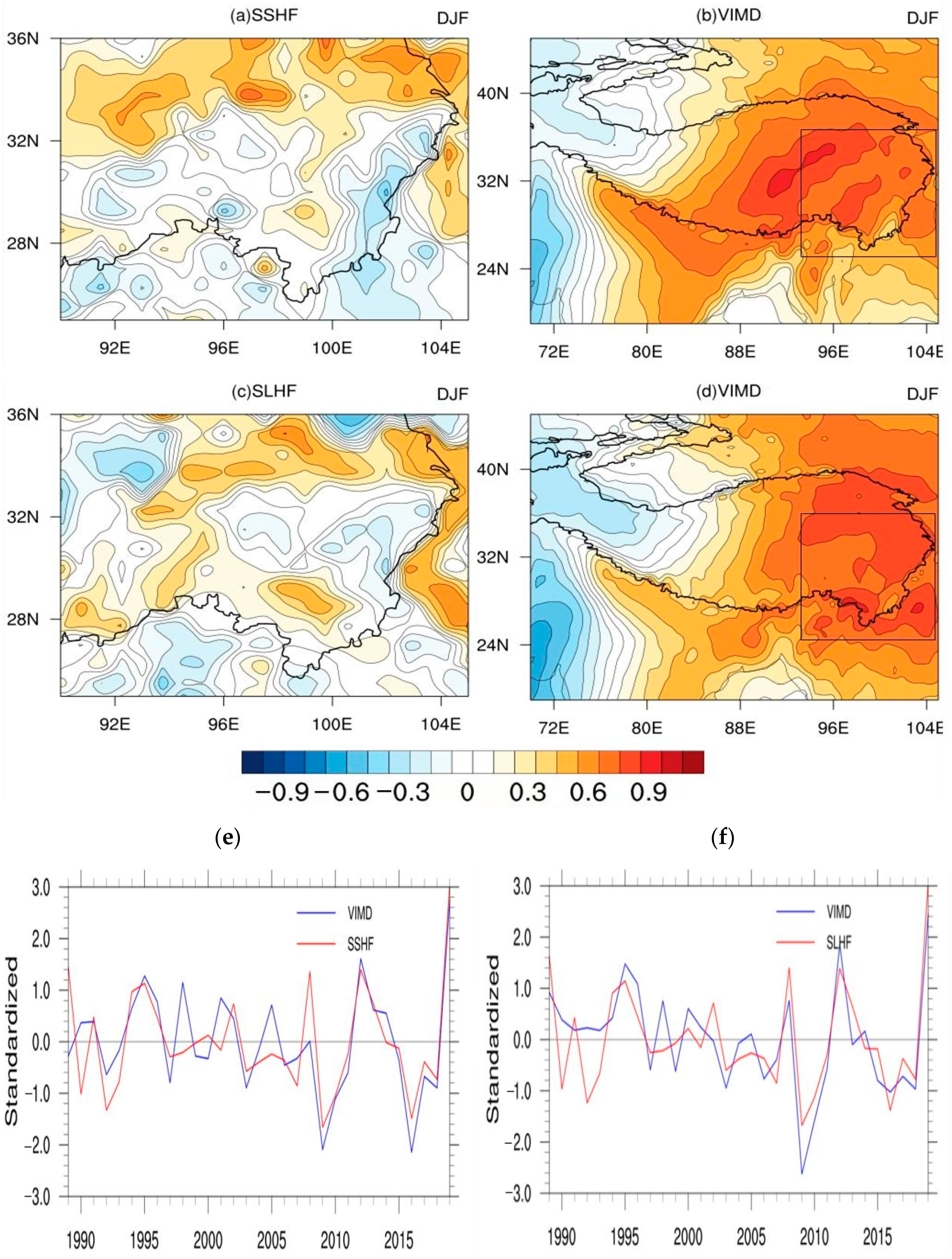
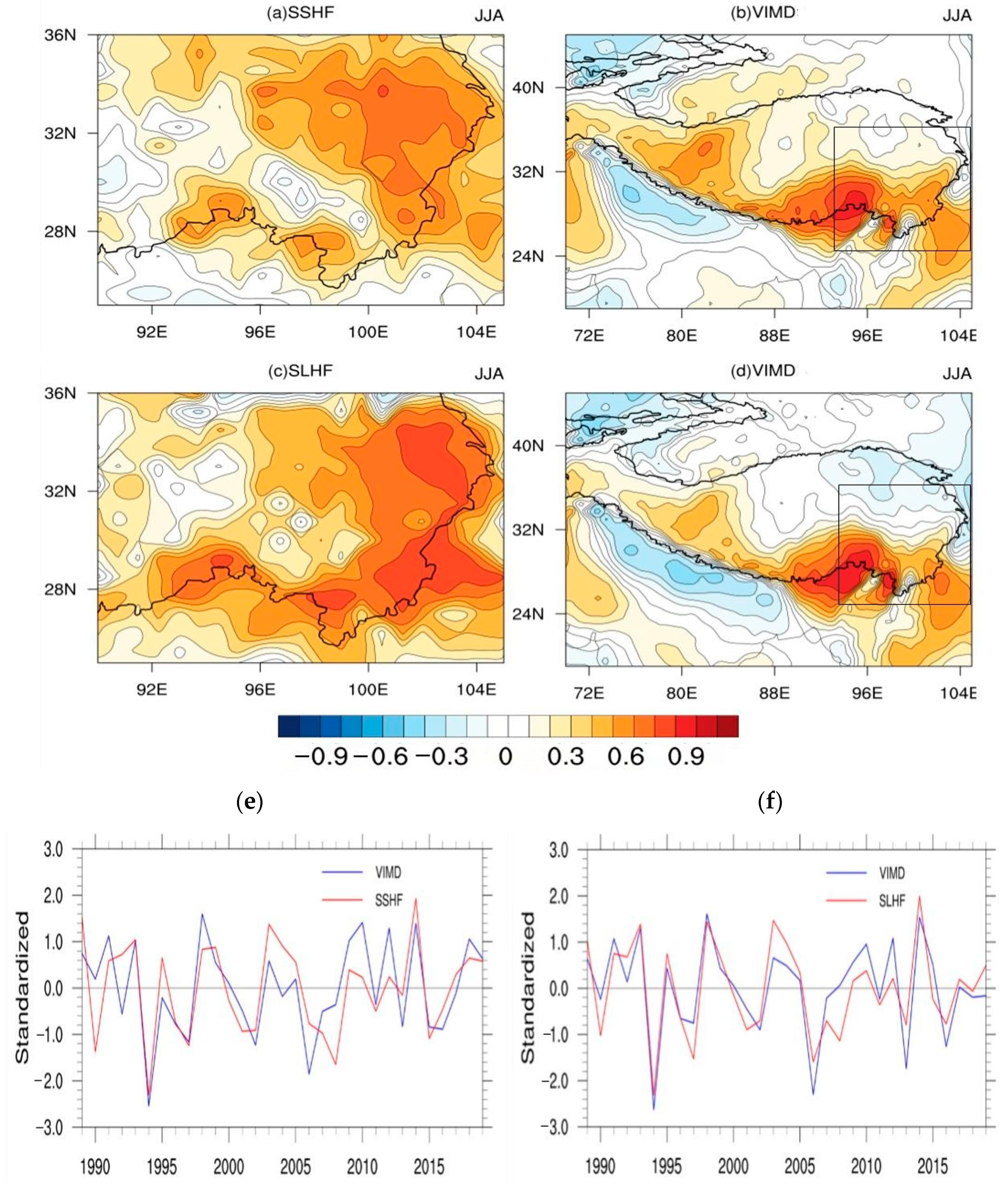
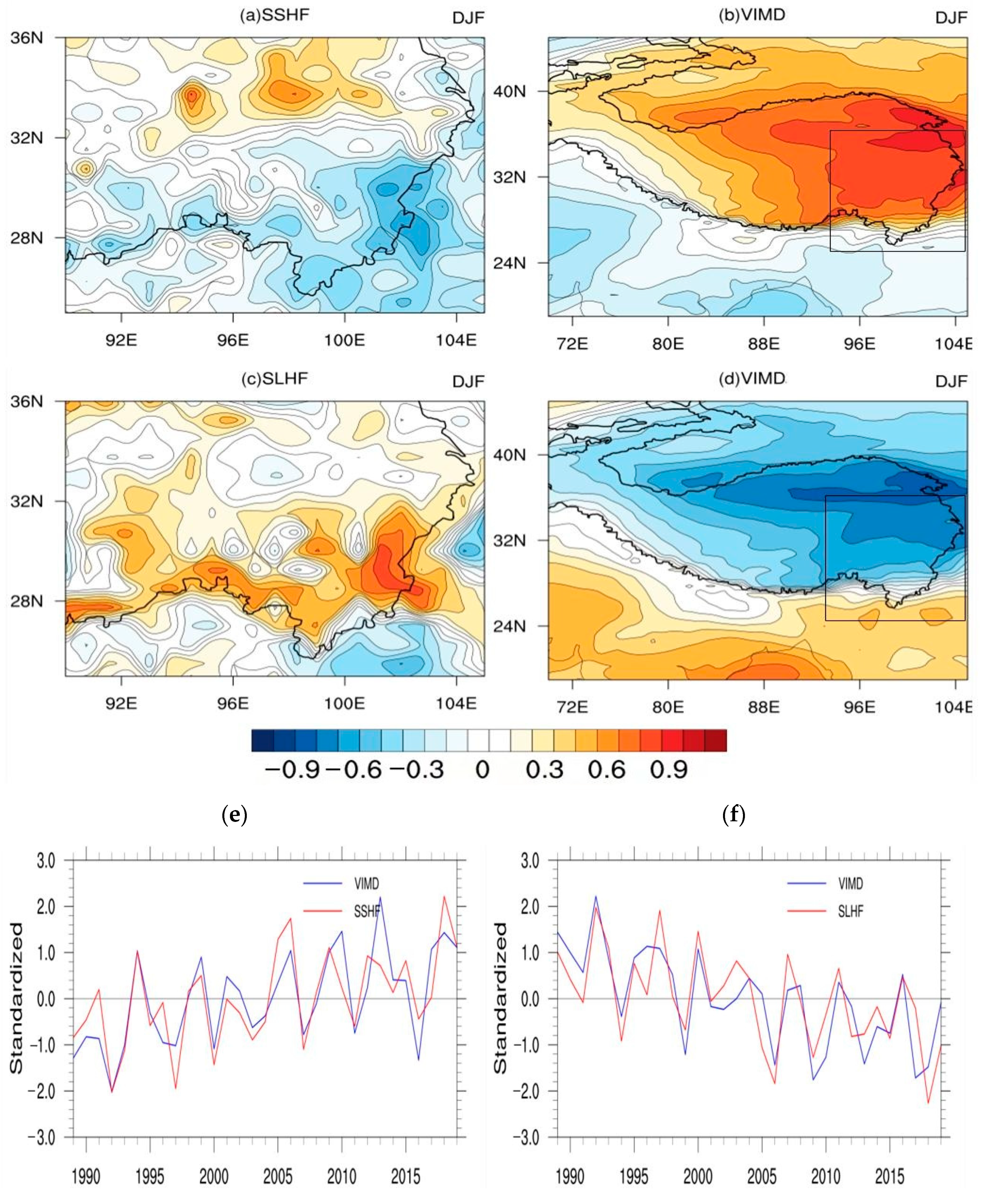

| Singular Vector | First Mode | Second Mode | Third Mode | Fourth Mode | CSCF (%) | ||||
|---|---|---|---|---|---|---|---|---|---|
| SCF (%) | R | SCF (%) | R | SCF (%) | R | SCF (%) | R | ||
| spring | 33.25 | 0.93 | 16.74 | 0.91 | 13.19 | 0.83 | 8.39 | 0.86 | 80.17 |
| summer | 75.35 | 0.94 | 11.43 | 0.93 | 6.08 | 0.92 | 1.64 | 0.90 | 94.49 |
| autumn | 48.79 | 0.91 | 19.57 | 0.93 | 8.93 | 0.84 | 5.12 | 0.87 | 82.41 |
| winter | 38.03 | 0.89 | 20.66 | 0.85 | 12.22 | 0.82 | 7.15 | 0.87 | 78.06 |
| all year | 44.57 | 0.85 | 20.58 | 0.86 | 10.19 | 0.80 | 5.80 | 0.84 | 81.13 |
| Singular Vector | First Mode | Second Mode | Third Mode | Fourth Mode | CSCF (%) | ||||
|---|---|---|---|---|---|---|---|---|---|
| SCF (%) | R | SCF (%) | R | SCF (%) | R | SCF (%) | R | ||
| spring | 36.98 | 0.95 | 20.20 | 0.86 | 12.87 | 0.82 | 8.85 | 0.83 | 78.10 |
| summer | 77.46 | 0.94 | 9.88 | 0.93 | 4.05 | 0.87 | 2.25 | 0.85 | 93.64 |
| autumn | 52.31 | 0.90 | 21.15 | 0.95 | 8.88 | 0.91 | 4.34 | 0.92 | 86.68 |
| winter | 43.20 | 0.93 | 17.11 | 0.89 | 12.91 | 0.93 | 5.94 | 0.89 | 79.15 |
| all year | 47.67 | 0.87 | 21.13 | 0.89 | 8.98 | 0.82 | 5.93 | 0.85 | 83.71 |
| Singular Vector | SSHF | SLHF | ||||||
|---|---|---|---|---|---|---|---|---|
| Summer | Winter | Summer | Winter | |||||
| SCF (%) | R | SCF (%) | R | SCF (%) | R | SCF (%) | R | |
| 1 | 68.15 | 0.83 | 76.41 | 0.78 | 61.89 | 0.85 | 78.52 | 0.80 |
| 2 | 20.82 | 0.74 | 13.31 | 0.78 | 24.91 | 0.77 | 11.70 | 0.81 |
| 3 | 5.86 | 0.76 | 4.66 | 0.82 | 6.40 | 0.79 | 3.96 | 0.83 |
| 4 | 2.08 | 0.84 | 1.94 | 0.87 | 3.03 | 0.81 | 1.81 | 0.82 |
| CSCF (%) | 96.90 | / | 96.32 | / | 96.23 | / | 95.98 | / |
| Singular Vector | SSHF | SLHF | ||||||
|---|---|---|---|---|---|---|---|---|
| Summer | Winter | Summer | Winter | |||||
| SCF (%) | R | SCF (%) | R | SCF (%) | R | SCF (%) | R | |
| 1 | 83.37 | 0.77 | 73.02 | 0.80 | 87.85 | 0.85 | 72.01 | 0.79 |
| 2 | 11.22 | 0.63 | 19.55 | 0.71 | 7.88 | 0.74 | 19.51 | 0.71 |
| 3 | 2.29 | 0.79 | 2.83 | 0.74 | 2.12 | 0.71 | 3.64 | 0.89 |
| 4 | 1.68 | 0.80 | 2.08 | 0.79 | 0.87 | 0.80 | 2.31 | 0.84 |
| CSCF (%) | 98.55 | / | 97.48 | / | 98.72 | / | 97.46 | / |
Publisher’s Note: MDPI stays neutral with regard to jurisdictional claims in published maps and institutional affiliations. |
© 2021 by the authors. Licensee MDPI, Basel, Switzerland. This article is an open access article distributed under the terms and conditions of the Creative Commons Attribution (CC BY) license (https://creativecommons.org/licenses/by/4.0/).
Share and Cite
Li, M.; Wang, L.; Chang, N.; Gong, M.; Ma, Y.; Yang, Y.; Chen, X.; Han, C.; Sun, F. Characteristics of the Water Vapor Transport in the Canyon Area of the Southeastern Tibetan Plateau. Water 2021, 13, 3620. https://doi.org/10.3390/w13243620
Li M, Wang L, Chang N, Gong M, Ma Y, Yang Y, Chen X, Han C, Sun F. Characteristics of the Water Vapor Transport in the Canyon Area of the Southeastern Tibetan Plateau. Water. 2021; 13(24):3620. https://doi.org/10.3390/w13243620
Chicago/Turabian StyleLi, Maoshan, Lingzhi Wang, Na Chang, Ming Gong, Yaoming Ma, Yaoxian Yang, Xuelong Chen, Cunbo Han, and Fanglin Sun. 2021. "Characteristics of the Water Vapor Transport in the Canyon Area of the Southeastern Tibetan Plateau" Water 13, no. 24: 3620. https://doi.org/10.3390/w13243620
APA StyleLi, M., Wang, L., Chang, N., Gong, M., Ma, Y., Yang, Y., Chen, X., Han, C., & Sun, F. (2021). Characteristics of the Water Vapor Transport in the Canyon Area of the Southeastern Tibetan Plateau. Water, 13(24), 3620. https://doi.org/10.3390/w13243620








